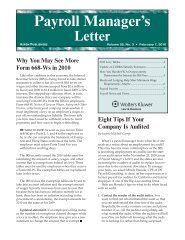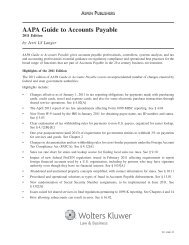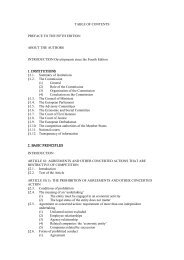journal of pension planning & compliance - Kluwer Law International
journal of pension planning & compliance - Kluwer Law International
journal of pension planning & compliance - Kluwer Law International
Create successful ePaper yourself
Turn your PDF publications into a flip-book with our unique Google optimized e-Paper software.
EDITOR’S NOTE / vii<br />
The court stated that in the ordinary case <strong>of</strong> ERISA estoppel, the<br />
question would be whether reliance on written or oral statements was<br />
reasonable given the contradictory terms <strong>of</strong> the plan. [ See, e.g., Bratton<br />
v. Schlumberger Tech. Corp. Pension Plan, 299 F. App’x 375, 377 (5th<br />
Cir. 2008); High v. E-Systems, Inc., 459 F.3d 573, 580 (5th Cir. 2006).]<br />
The situation in this case was unusual because the top-hat plan had<br />
no written document that could be contradicted. Although Belmonte<br />
and Utley spoke only twice about his retirement benefits, the lack <strong>of</strong> a<br />
written document to put Belmonte on notice that the plan was different<br />
than his expectations made it more plausible that he would rely on<br />
oral representations. EMSI called attention to Belmonte’s position as a<br />
corporate vice president and questioned whether it was plausible that<br />
such a sophisticated person would believe such a casual assertion after<br />
having expressed a desire to see it in writing, a desire that was never<br />
fulfilled. The court stated that this, however, went to the credibility <strong>of</strong><br />
Belmonte and was not appropriate to resolve within the context <strong>of</strong> a<br />
motion to dismiss for failure to state a claim. The court stated that, on<br />
balance, Belmonte’s statement <strong>of</strong> facts alleging reasonable reliance was<br />
sufficiently plausible to satisfy the Twombly standard.<br />
The second question before the court was whether Belmonte had<br />
sufficiently pled extraordinary circumstances. EMSI argued that Belmonte<br />
had failed to state a claim because it did not allege any egregious<br />
circumstances amounting to bad faith, active concealment, or fraud<br />
that would have met the standard in Burstein . Belmonte responded by<br />
arguing that more recent precedent in the Third Circuit showed that<br />
the facts he alleged amounted to extraordinary circumstances because<br />
they involved a significant amount <strong>of</strong> money and representations that<br />
occurred over a long period <strong>of</strong> time (citing Pell v. E.I. DuPont De<br />
Nemours & Co., Inc., 539 F.3d 292, 304 (3d Cir. 2008)). EMSI countered<br />
in its reply that Belmonte misconstrued the Third Circuit authority<br />
from Pell .<br />
Belmonte alleged four facts that he believes demonstrate extraordinary<br />
circumstances:<br />
(1) the representation <strong>of</strong> $1,000 per month for 15 years<br />
came from EMSI’s president and sole owner, Mr. Utley; (2)<br />
no summary plan description or plan documents were ever<br />
provided to Belmonte or ever existed; (3) Belmonte received<br />
nothing in writing and no oral communication that would<br />
indicate that the representations made by Mr. Utley were<br />
false; and (4) EMSI initially denied the very existence <strong>of</strong> the<br />
EMSI Belmonte Plan, and continued to do so until after<br />
Belmonte filed this lawsuit . . . .






